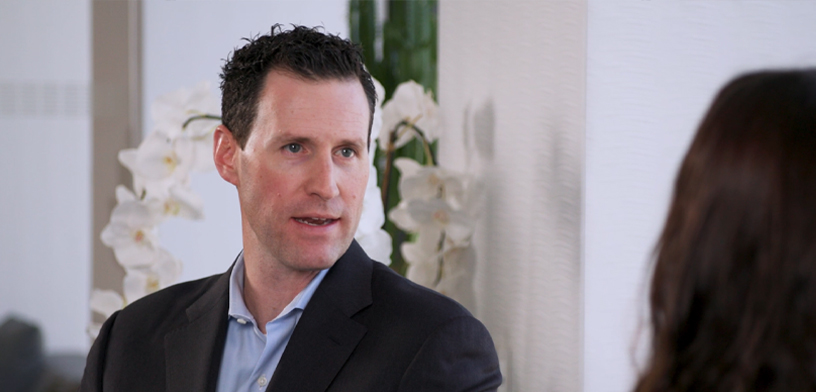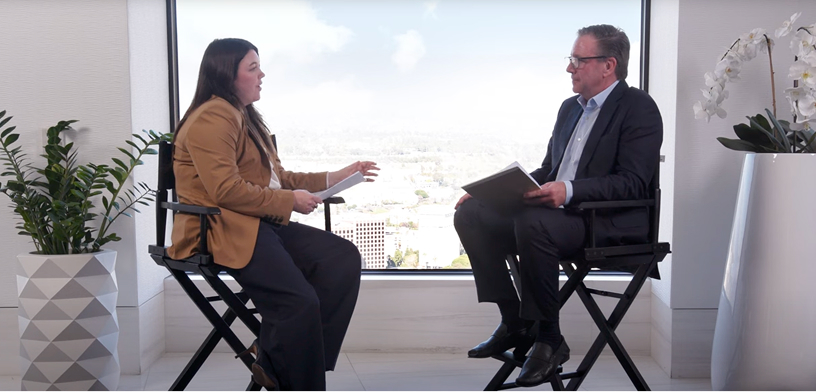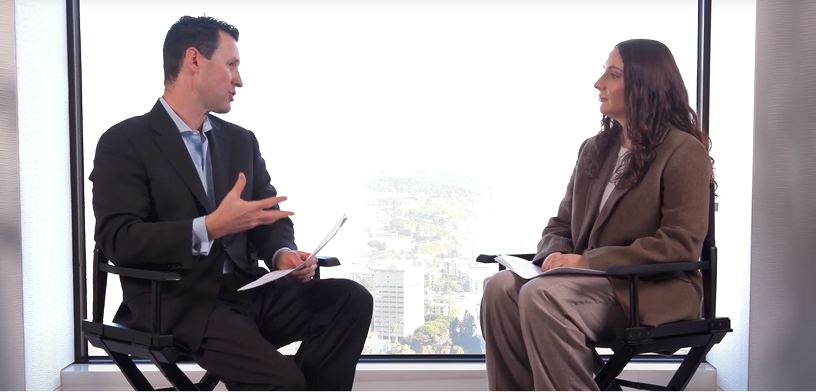In Conversation: Real Estate Distress and Opportunities
Headlines would leave many to believe that real estate is in despair, facing a wall of distressed loans and declining values. Are those headlines accurate, or is the distress being overblown? And in a down market, where are the opportunities? ARA Chairman and CEO Stanley Iezman covers these questions and more in his conversation with Managing Director of Research and Strategy Sabrina Unger.
Stanley Iezman: Today we will be talking about distress in the real estate market and what that means. Is there really distress? Or is this just a figment of our imagination?
Sabrina Unger: I think we have to first contextualize how “real” the distress in the market is today, as well as the potential distress, because there are two buckets that we need to be focused on.
If you look at the end of 2023, we had something like $85 billion of real estate loans that were already distressed. These are loans that the lenders have identified as falling effectively into default, with delays in payments. That’s a huge bucket of money right there.
Then we have another $230 billion that is potentially distressed, meaning it’s right on the cusp of moving into that distress category. These are big numbers. So when we think about how far along are we into the materialization of this distress situation, and is it real? Should it be concerning, or is it getting overblown? We’re past the opening credits, but it’s going to be a long movie.
If I think about it in the realm of Titanic, we’re probably not to the second VHS yet. There’s a lot that needs to be worked through. The concerns are warranted, because not all of these loans are going to come through the current environment unscathed. But we may have been a little premature on thinking that it was going to materialize sooner than when it actually will.
SI: So help us contextualize this again in a different way. How do we wind up in this position? What is the genesis of all this?
SU: Not that long ago, interest rates were low. When you went to invest in a real estate property, adding debt or leverage was accretive to returns, and it was relatively affordable to do.
If we think about an example: if you’re an investor who had the unfortunate timing of buying an office property at the end of 2019, there was really affordable accretive debt [available].
So you go to buy a $100 million office property, for simple math, and you take a 60% loan to value. Effectively the loan is $60 million and you, the equity contributor, have to come up with $40 million, and you get a five-year loan. Then the pandemic hits, and your occupancy takes a hit when things start to recover. Now you’re having to compete for leasing. So it’s costing more in tenant improvement, more in leasing commissions. Meanwhile, interest rates went up, and your values have declined. Now you’re sitting in 2024 and that loan that was very low, maybe it was 2% interest, is coming due in an environment where loans are 6, 7, 8%, depending on the profile of the asset. You are now are faced with effectively three decisions, which is one, you can just pay off that loan.
But again, if the value of your office declined, the amount of the outstanding loan may be equivalent or more to the value of the building. So where are you going to come up with the money to pay off that loan? That’s one scenario, but it’s probably not super likely. The second is you deal with the environment and say, I’m going to refinance. But again, because the value has declined, now that loan to value is thrown off. You have to come up with more equity. People probably are not generally in a position where they want to do that, particularly for office – to put more money into a property that just lost 40% of its value. But that’s option two.
And the third option, which is what the markets are really concerned about, is effectively you default on that loan as it comes due. You can’t and you don’t want to pay it off. You don’t want to put more equity in, so you effectively hand the keys to that property back to the lender. Those are your three scenarios.
It stems from an environment where for so many years, debt was very cheap, easy to get, and was accretive to your returns. And now we’re in an environment where it’s considerably more expensive to refinance, and values have declined.
Office is probably in the worst place with this because it’s getting hit with a triple punch. It’s dealing with lower occupancy due to work-from-home. We have the capital markets, the interest rate environment, which is making it more expensive to refinance. And you also just have lower values. So one, two, three, it’s very difficult to justify refinancing, especially in office, given this environment.
That is where a lot of the concerns about true default are coming in.
SI: That is a lot to unpack. And I want to parse this out for a moment and try and understand it. Where is all this capital going to come from? That’s going to be necessary to be able to refinance this debt or to re-margin these loans that have to be bought down as you talk about.
SU: I’m going to pick on office a little bit because it represents something like 41% of the distressed loans today. And we know that it’s really the problem spot from a fundamentals perspective, as well as representing a big portion of the debt. Where does the capital come from?
Well, it’s likely not going to come from CMBS market, because they already have something like 30% exposure. Lenders have already said they don’t want to be lending to office right now. They’re a little apprehensive about lending to real estate, but especially office. So you’re not going to see them plug the gap.
Where I think you’re seeing more capital get churned up is from non-traditional lender sources. You’re seeing funds be raised to fill that gap, which is great. I think the challenge, though, is these funds, what their target return is and what they’re willing to accept from a risk-return profile may not match up with the assets and profiles of deals that are going to need that lending to step in.
So there may be a mismatch in the market between available capital that wants to be placed as an alternative and what’s going to be available for them to step into. So we may still see a challenge there, but I think that is an opportunity where non-traditional lenders are going to get an opportunity to step in where the banks have stepped back.
SI: Let’s frame this a little differently, because office has become the punching bag. And we all know that there are real issues there, but let’s move to industrial, retail, and multifamily.
We’ve moved into a cap rate environment that is materially different. In terms of your debt coverage, how do you think this plays out in those areas?
SU: Looking at the composition of what is already distressed today, office is 41% of what was distressed at the end of 2023. But if we look at the next tier of what constitutes that bucket, it’s lodging, retail, and apartments combined. Those three sectors represent 54% of distress. And when you look at potential distress, so it hasn’t moved into that threshold, but it’s close, a lot of it is apartments. I think that’s going to create a really interesting buying opportunity, because the longer-term fundamental outlook for rental residential is much stronger than office.
I think there is going to be a really interesting buying opportunity for groups because there were so many multifamily deals that had really interesting financial structures that are no longer viable in today’s environment.
SI: So when we think about managing in a distressed environment, most of the asset management team in many firms are too young to really understand what it is to be able to manage through a cycle like this.
The management skills that are necessary are very different than what you would do in a market that is robust and upwardly moving. I mean, it’s pretty easy to be able to lease when everybody’s leasing property, and it’s very difficult to lease when nobody’s leasing property. And you have to change those strategies and link it to your debt strategy. How are you thinking about this today?
SU: I think what we’ve been communicating and will continue to communicate in this environment is focusing on the resiliency of your NOI, or your net operating income. That is so pertinent today because you have to be a first mover.
If you’re in a multifamily market facing a lot of supply and you have a debt consideration to be thinking about, you need occupancy. You need to be on the front end of offering concessions if that’s warranted in the market, ensuring that you’re retaining tenants so that your cash flow stays as stable as possible.
Again, pre- this era of higher interest rates, the idea was you wanted to churn tenants because there was an ability to increase rents. Today, I think the focus has shifted to the resiliency and stability of income. And that’s also going to be rewarded, I think, first by the capital markets because there’s still so much uncertainty that if you’re going to refinance or work with your lender, they want to see a stable occupancy profile. So I think that’s critical.
SI: In our Investment Committee meetings, a favorite topic is: do you talk about buying office? Do you not talk about buying office? And what are the political implications with your investors, and how do they perceive that? Or even buying into this market today, where you don’t necessarily know where basis is given the distress that is occurring.
How do you think about that? And is there an opportunity that we’re missing? Should we go buy office buildings in downtown Los Angeles at $70 a foot? Because the replacement cost is $1,000 a foot. Is there going to be real value there? Give us some context on that.
SU: I think it ultimately depends on your structural view of fundamentals and demand, because it’s great to be able to get a building at a good basis, but it only benefits your portfolio if you’re able to lease it up and get cashflow on it, and then sell it at the end of the day. So if you buy a building at 70% below what you would have bought it for a few years ago, that sounds like a great deal, but if you can never get it leased up, and you’re facing chronic vacancy issues, and the taxes are going up around you, and it’s more expensive to operate it and to manage it – that’s not a great buy. So I think it really comes back to what is your fundamental view on whether a) we have a return to past, return to office that is commiserate with what we had before the pandemic. I think that’s the first part, and then assuming we do, assuming at some time in the future, we do come back to five days a week, b) is it in the same locations? Or have people fundamentally distributed in such a way where downtown Los Angeles will struggle for much longer than some of the submarkets on the West Side because not only did the businesses sort of up and leave, but their employees live over there as well. And we have to think about things like commute.
So I think it really comes down to what’s your fundamental view of the recovery of demand and over what period of time. Because again, it could be a great buy today, but if you don’t think you’re going to be able to make money for 10 or 15 years, there’s probably a better place to make that investment.
SI: As you and I talked about in our House View, one of the things that we’re going through right now is what I call “the great reset”, the great basis reset, where basis is all being reset to a much greater opportunity for people to buy. So I think what we want to do is let everybody walk away from this conversation realizing that even in the midst of distress, there are opportunities to be able to capitalize and to be able to invest.
SU: Absolutely. I think vintage year is so important. Basis is important. And there are going to be some good basis buys that come out of this reset. I think it’s an exciting time to think about what happens for the next cycle.
This transcript of the ARA In Conversation discussion has been edited for clarity.


